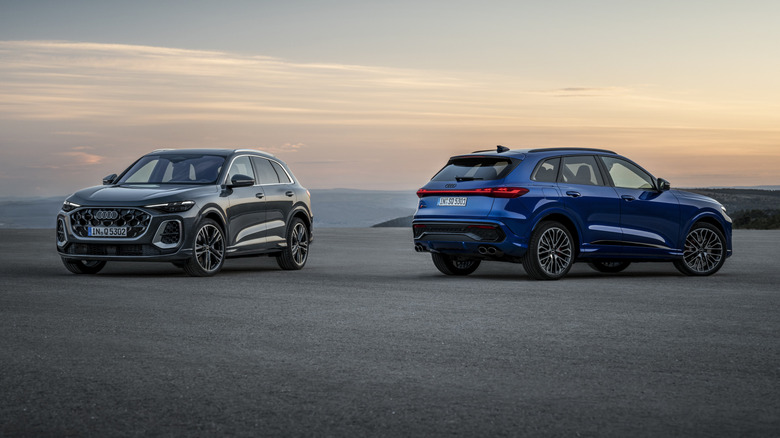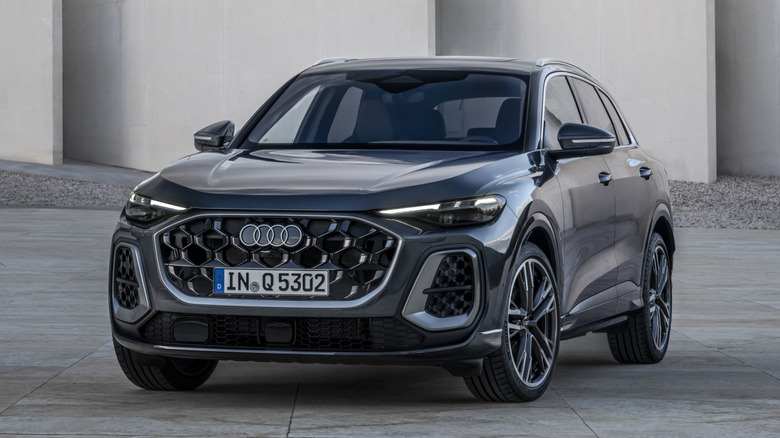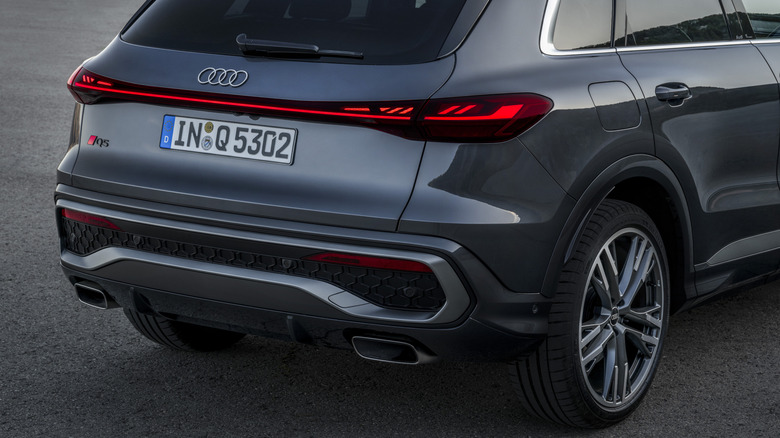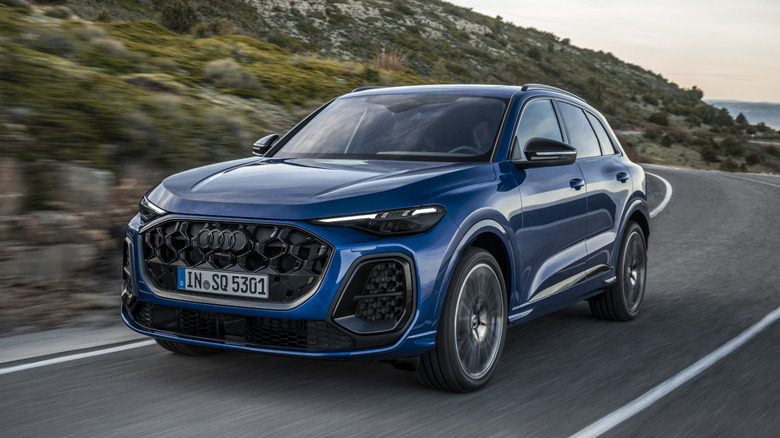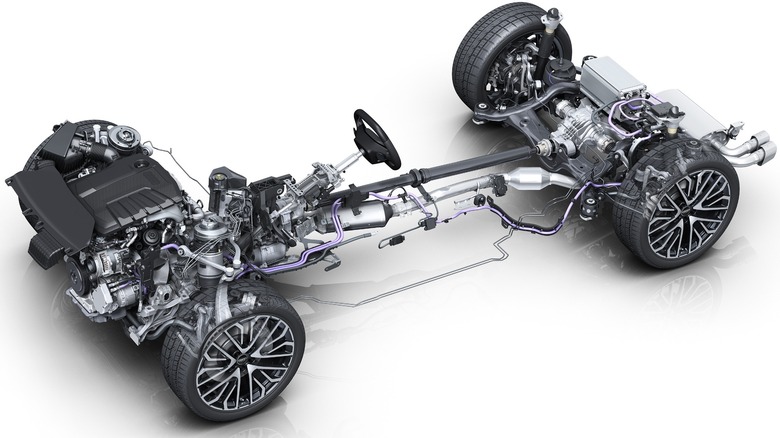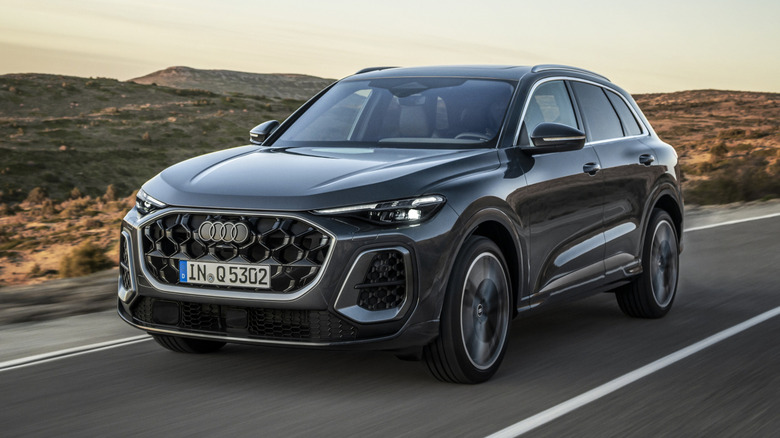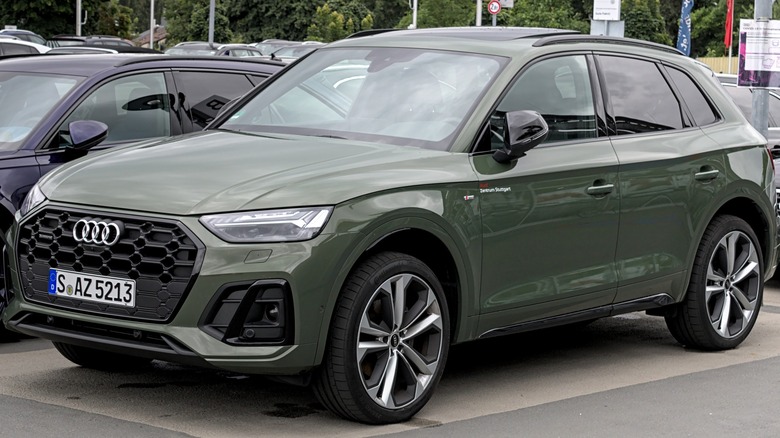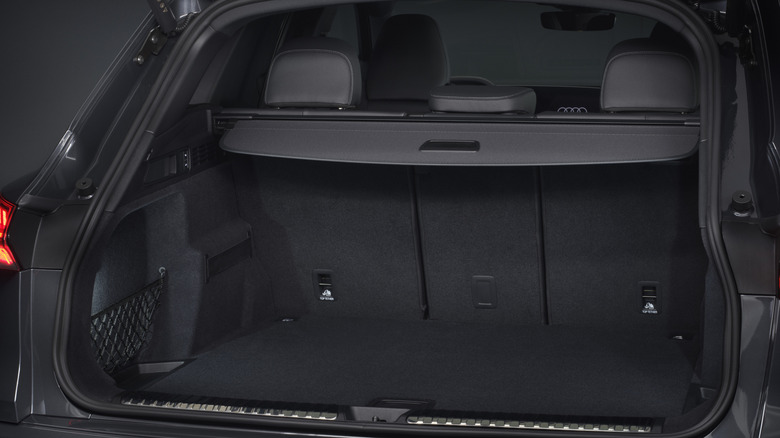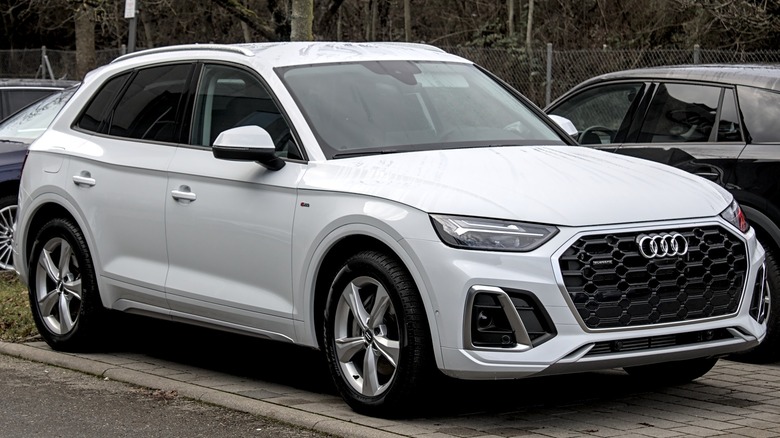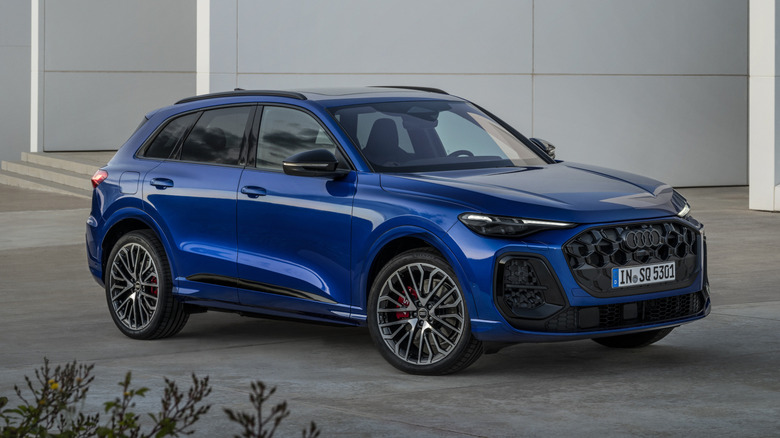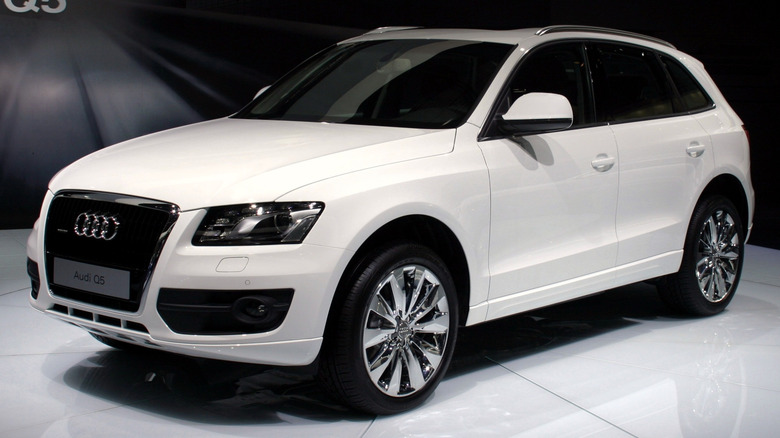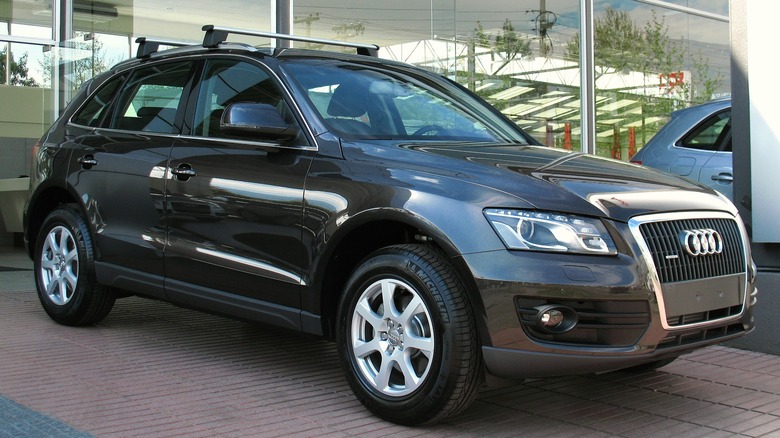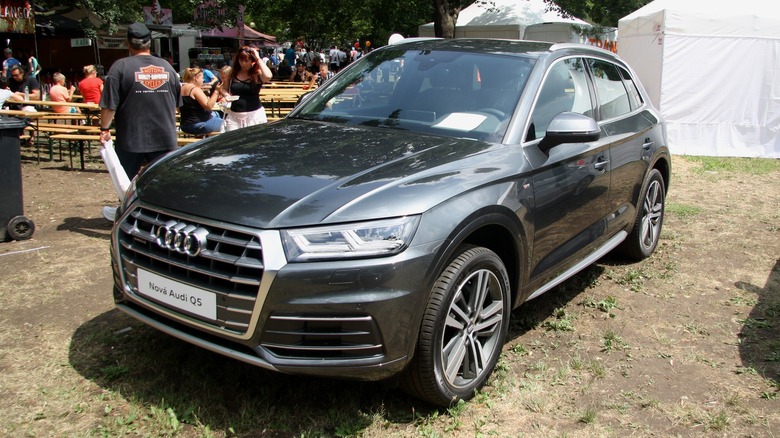13 Things You Should Know Before Buying Audi Q5 (New Or Used)
If you've spent time on U.S. roads and highways over the past few years, you'll know that crossovers are a big deal. These car-meets-SUV hybrids account for 45% of all U.S. passenger vehicle sales as of June 2022, with various brands and nameplates all contributing to the glut. One of the most popular ones is undoubtedly Audi's Q5, soon to enter its third generation.
The Q5 is a genuine best-seller, and it's not hard to see why. It offers a comfortable and refined ride, with solid engines and good transmissions, coupled with enjoyable — but not too sporty — handling. The Q5 isn't the sportiest crossover out there, but it's safe and sensible... and isn't that what you want when you're shopping for a crossover?
If that sounds right, the Audi Q5 may be perfect for you. But even if you're dead-set on going for a Q5 over its many rivals, there's a lot you should be aware of before you take the plunge, from maintenance costs to engine options and some possibly dangerous faults. Here are some of the most important things to know before you buy an Audi Q5, new or used.
The 2025 Q5 is the nameplate's third generation
Audi has opted for a slow and steady approach to the Q5, with the 2025 model being only the third generation of the compact SUV despite the model's debut in 2008. Audi opted to keep the Q5 in its initial form for nearly a decade, only debuting the second-gen Q5 in 2017 — albeit with a first-gen facelift in 2013.
With such a considered development pace, you'd expect the third-generation Q5 to bring many new changes. And it does, whether you're talking about big-picture changes or more immediate benefits. One of the more notable changes is the move to Audi's new Premium Platform Combustion (PPC) architecture, which it shares with the new A5 sedan. This brings, amongst others, an updated mild-hybrid system, although that's only for European Q5s — more on this later.
Other third-gen upgrades and changes include a Frequency Selective Damping system, updated driver assists, and Audi's screen-heavy Digital Stage infotainment setup, which it shares with the A5. The 2025 Q5 will treat owners to an 11.9-inch cockpit screen and a 14.5-inch MMI touch display as standard, with an optional 10.9-inch MMI Passenger Display also available. You also get a voice control system and several charging options, including a Qi wireless charger and four USB-C ports (two front, two rear).
Real exhausts return for 2025
The Q5's new PPC platform means that one of the more contentious aspects of the second-generation Q5 and SQ5 — the fake exhaust tips — is finally going the way of the Dodo. Are fake exhaust tips the gravest sin a car manufacturer could make? No, of course not. But it seems somewhat silly to use them in gasoline-powered cars, which the Q5 most definitely has been (and will continue to be, at least for the time being).
Thankfully, Audi seems to have heard all the complaints about its fake exhausts. A company spokesperson told Auto Express that all PPC-based vehicles will have functional exhaust pipes — no more under-bumper exhausts for the big Audis once they move to the new platform. This includes the A5, S5, and Q5, with the eventual next-generation A7 and Q7 also likely to have genuine exhaust tips, presuming they use the new platform.
Audi stopped short of confirming whether it will also reintroduce hot exhausts to its smaller MQB-based cars, though. So you may still have to live with fake exhausts on your Audi RS3 even when it introduces a new generation.
There's an S version for the performance-minded
Like some of Audi's other models — the A3's S3 and RS3 variants, for example — the German manufacturer sells two versions of the Q5. There's the standard Q5, with its 200-plus horsepower TFSI inline-four engines, and then there's the SQ5, which the company introduced in 2013 with 300-hp-plus 3.0-liter diesel and gas engines. By the time of the second-generation SQ5, the 3.0-liter gas V6 was making 354 hp and 369 lb-ft of torque, offering what reviewers considered a good balance of performance and comfort — complete with an impressive zero to 60 time of 4.7 seconds.
The SQ5 will return for the third-gen SQ5 with a few notable upgrades. The 3.0-liter V6 now produces 362 hp and 406 lb-ft of torque, a welcome — if not necessarily game-changing — increase from the second-generation SQ5. The sporty SUV will also have Audi's S-tronic seven-speed dual-clutch transmission instead of the old SQ5's conventional eight-speed automatic transmission. The S-tronic impressed us in the 2024 Audi S3, so it should be a welcome addition to the new SQ5.
Audi's speccing an upgraded sports suspension for the 2025 SQ5, with reports indicating that the new-gen SQ5 will also exhibit more noticeable differences between its Comfort and Sport settings. The SQ5 also comes with 20-inch wheels at a minimum, with the option of going up to 21-inch alloys if desired.
No hybrid power for U.S. Q5s
The third-gen Q5 and move to the PPC platform brings with it an updated mild-hybrid system for all available powertrains, from the base 201-hp 2.0-liter TFSI up to the range-topping 362-hp 3.0-liter V6 in the Audi SQ5. The new Q5's MHEV plus puts out an extra 170 lb-ft of torque and 24 hp of power and comes with a 48-volt charging system — at least, in European Q5s.
U.S.-bound third-generation Q5s won't have any such fanciness. Instead, Audi opted to keep things simple for the Q5's American debut, so owners don't need to consider the sometimes complex pros and cons of buying hybrid vehicles. The U.S. Q5 and SQ5 will only be available in pure gasoline form without hybrid power, at least at launch. This will likely be good news for die-hard internal combustion fans, but it's hard to imagine that many would consider a Q5 or SQ5. After all, they're likely more concerned with celebrating gasoline holdouts like the 2024 Ford Mustang.
To be clear, Audi has told Car and Driver that the PPC platform is set up for plug-in hybrid power and that it expects to debut PHEV Q5s later in 2025. So, the Q5 may not be gasoline-only in the U.S. for its entire run — although we'll have to wait and see on that one.
U.S. Q5s get a beefier standard engine
Gasoline-only engines aren't the only powertrain difference between European and U.S. market Q5s. Over the past decade or so, Audi has offered two inline-four gas engines in European Q5s: a basic 201 hp, 236 lb-ft powerplant and a higher-output 261 hp version. Both engines were available through the second generation's lifespan and the company plans to continue offering them once the third-generation Q5 debuts.
But that wasn't the case for the second-generation U.S.-market Q5, which only came with the 261 hp, 273 lb-ft inline-four under the hood, which Audi mated to a seven-speed dual-clutch transmission. And that's not going to change with the 2025 Q5: Audi will once again only offer the U.S.-market Q5 with the higher-powered version of its 2.0-liter TFSI engine. There is one difference, though: the third-gen Q5's power climbs from 216 hp to 268 hp — not a major boost, but we don't think anyone would turn their nose up at an extra seven horsepower.
We'd expect a bit more torque to go with the power boost, too, especially considering the 37 lb-ft increase the SQ5's engine is getting for 2025. However, Audi has yet to reveal torque numbers for the updated inline-four engine, so we'll have to wait and see.
The Q5 is Audi's best seller
Crossovers are big business, so it's probably not a huge surprise that the Q5 is Audi's best-selling model. It's a hit worldwide, with the company moving 331,928 units in 2023, accounting for around 17% of the 1.9 million vehicles it sold that year. But while everyone seems to love the Q5, American buyers love it just that little bit more, with the biggest share — 44%, to be exact — of Q5 sales coming from the U.S.
Audi sold more than 50,000 Q5s for most of the decade between 2013 and 2023. Quite a few years saw more than 60,000 units leave dealer forecourts, too, and the nameplate peaked in 2023 with 74,143 units making their way to driveways across the U.S. Even the worst years of this decade-long run were still ahead of the competition, with the roughly 40,000 units sold in 2012 and 2013 easily besting the sub-40,000 unit sales of BMW's wildly successful X3 during that same period.
[Image by Alexander Migl via Wikimedia Commons | Cropped and scaled | CC BY-SA 4.0]
It doesn't have as much cargo space as some rivals
The Q5 has always had a lot going for it, whether it's the standard Q5's comfortable, luxurious experience or the SQ5's impressive ability to retain the base model's refinement while adding an extra hundred or so horsepower into the mix. But it's not quite a home run, with the Q5's interior room falling somewhat short of expectations.
Rear legroom has always been a pain point, with reviewers and owners pointing out the somewhat tight seating arrangement for rear passengers. But another area where the Q5 stumbles slightly is cargo space: Audi claims 54 cubic feet of space with the rear seats folded down, which, while decent, isn't nearly as much as some competing crossovers.
The highly-regarded Kia Sportage, for example, offers 74.1 cubic feet of room with the rear seats folded flat and the dual-level cargo floor in the lower position, or 69.3 cubic feet with the floor in its higher position — all while being slightly shorter and narrower than the Q5. And it's not just Far East rivals that have the Q5 beat here: Ford's Bronco also bests the Q5 here, with 77.6 cubic feet of space available in any of its many trim levels.
Used prices come down quickly
If you're not quite ready to stump up the $45,000 or so for a 2025 Audi Q5, but want a luxury German crossover in your life, shopping for a used Q5 might be your best bet. Unlike some other popular crossovers, prices on Audi Q5s drop quite quickly, making them quite an appealing option on the used market.
Let's take the relatively new 2022 Audi Q5, only a two-year-old car at the time of writing. Kelley Blue Book estimates that you should be able to buy a decent used example for around 60% of MSRP, with the site quoting a fair purchase price of around $36,000 for a Q5 Prestige with the 261 hp inline-four. Sure, that's still a good chunk of change, but it's a bargain compared to the $60,000 or so you would have paid when new.
Compare that to 2022 Toyota RAV4s, which still apparently sell for nearly the same price as new, and the Audi Q5 quickly starts feeling like a bit of a bargain. Sure, the RAV4 is a great SUV, but we wouldn't blame you for looking at used prices for the two crossovers and deciding that the Audi's European flair was the way to go.
[Image by Alexander Migl via Wikimedia Commons | Cropped and scaled | CC BY-SA 4.0]
Watch out for long-term costs
Type "Audi Q5 maintenance costs" into your search engine of choice, and you'll find several Reddit threads started by concerned new owners and first-time buyers worrying about long-term costs. And while some of the fears are perhaps exaggerated, it's still important to acknowledge that running a Q5 isn't quite the same as a bog-standard family car.
RepairPal estimates that Audi Q5s will cost around $920 annually to maintain, slightly higher than the $807 average for mid-sized luxury SUVs. It's also just under $300 more than the average annual maintenance price for all vehicle types in the U.S., which sits at $652. The site also estimates that Q5s come in for repairs more often than usual, with 1.2 repair visits a year compared to the 0.6 visits of other luxury SUVs. Depending on your perspective, this alone could be bad enough to make the Q5 an Audi model to avoid.
That said, it's not all doom and gloom. Owners will admit that some repair and maintenance tasks cost more — $150-200 for oil changes, for example — but the crossover still has its ardent fans. It's going to be pricier to maintain than a Honda CR-V, but you're arguably getting a lot more car for your money.
Reliability isn't necessarily the Q5's strong suit
Don't be alarmed. We're not saying the Q5 is an unreliable car — after all, we named the 2016 Q5 one of the most reliable Audis you can buy. It's just that the Q5 isn't exactly an outstanding performer; it's not bad enough to avoid — 2014 model aside — but you shouldn't buy a Q5 expecting a rock-solid, totally trouble-free daily driver.
J.D. Power's consumer ratings put the past few Q5 model years around the middle of the pack for its dependability and overall quality. Most model years, like the 2023 and 2020 Audi Q5, score around 70 or more points out of 100 for reliability, meaning they're fine, but not outstanding. That's okay enough, really: this shows that you're not likely to have too many headaches if you buy one.
Audi doesn't perform well in J.D. Power's Vehicle Dependability Survey, however, registering 252 problems per 100 vehicles in the 2023 study. It's unclear how many of these are Q5s, but it seems to back up RepairPal's estimation of more frequent mechanic visits for the Q5 compared to other vehicles.
The Q5 is a safe choice
Sporty handling and perky engines are all well and good, but many people considering an SUV have families and need extra room for all manner of more mundane tasks, be it carting the kids to soccer practice or taking the family for a quick weekend getaway. And when the lives of your loved ones enter the picture, safety becomes a much bigger priority when shopping for a car.
The past two generations of Audi's popular crossover have performed well in crash tests. The IIHS tested both generations of Q5 and found them excellent performers, scoring the highest possible rating ("Good") in most of the organization's tests. The 2012 Audi Q5 and 2023 Audi Q5 also made it to the IIHS list of top safety picks in their respective years.
The 2022 Q5 also scored five stars in the NHTSA's frontal and side crash tests. The rollover test wasn't quite as excellent, with the Q5 only scoring four stars there, but the overall picture is still a great one when it comes to occupant safety. The IIHS did ding the 2023 Q5 slightly for its overly short seatbelt warning sound, but that's hardly the most egregious safety-related issue a manufacturer has ever made.
[Image by Basilex via Wikimedia Commons | Cropped and scaled | CC BY 3.0]
2009 - 2012 Q5s have Takata airbags
The Takata airbag scandal is a seemingly never-ending saga, with vehicles from almost every big-name manufacturer built between the early 2000s and late 2010s shipping with these potentially fatal airbags. Audi was no exception, with the company installing Takata airbags in a wide range of its cars from that time.
Thankfully for Audi, most of its cars only used Takata airbags for a few years. There are some unfortunate exceptions, of course: take the Audi A3, for example, which used Takata airbags for eight long years (2006 to 2013). However, most used Audi buyers should only need to avoid two or three model years.
The Q5 sits somewhere in the middle of the two extremes, with four model years sporting the defective airbags. These are all from the pre-facelift first generation, which means there's a foolproof way of ensuring you don't get Takata airbags: go for a second-generation Q5. Facelifted first-generation Q5s are fine, too, as are any repaired first-gen Q5s. But if you're considering the latter, make sure you have proof that they've been repaired under recall before buying.
[Image by RL GNZLZ via Flickr | Cropped and scaled | CC BY-SA 2.0]
There's a do not drive advisory out for the 2018 Q5
Early 2010s Q5s aren't the only model years with potentially hazardous issues. The 2018 Q5 has a problem with its brake calipers, for which Audi and the NHTSA issued a recall in mid-2018. The recall involved just over 10,000 2018 Q5s, which suffered from improperly coated brake caliper pistons.
The issue, which stemmed from one of Audi's suppliers, meant that gas bubbles could form in the brake system. Given that air is compressible, unlike brake fluid, the presence of these bubbles will impact braking performance by increasing stopping distances and negatively impacting the effectiveness of a car's brakes. This can lead to crashes if a Q5 ends up taking longer than usual to come to a stop when braking.
Thankfully, most 2018 Q5 sold in the U.S. didn't have this fault: Audi shipped 69,978 Q5s that year, so most used ones you see will likely be trouble-free. That said, be sure to carefully check the service history of any 2018 Q5 you're looking at anyway, just in case.
[Image by Jiří Sedláček via Wikimedia Commons | Cropped and scaled | CC BY-SA 4.0]
